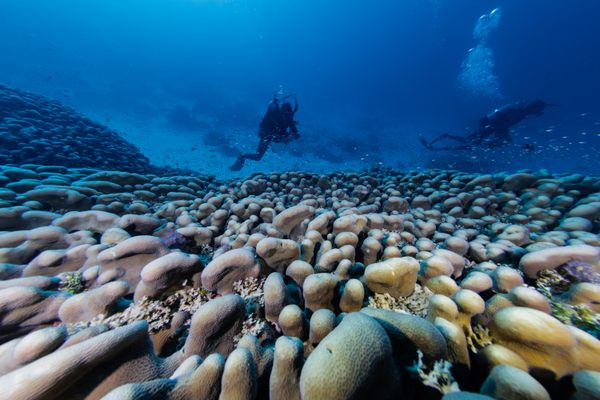Inside the Creation of Europe’s First Underwater Museum
One artist is literally going below the surface to spread his message.
 “The Raft of Lampedusa,” currently installed at the Museo Atlántico. (All sculptures and photos: Courtesy of Jason deCaires Taylor.)
“The Raft of Lampedusa,” currently installed at the Museo Atlántico. (All sculptures and photos: Courtesy of Jason deCaires Taylor.)
Off the coast of the Spanish island of Lanzarote, the easternmost of the Canary Islands, lies the completely submerged Museo Atlántico, an oceanic exhibition of the sculptures of British artist Jason deCaires Taylor.
The exhibit is a striking reminder of humans’ ever-changing—and often destructive—role in the modern world. A raft carries a dozen or so migrant refugees into an uncertain abyss. A mass of people walks dreamily into another world, some hiding behind the lenses of their cameras, some with eyes closed, some posing for a selfie.
But what’s visible now is only a small fraction of what this unique, underwater museum will become.
 “Rubicon,” one of the installations in el Museo.
“Rubicon,” one of the installations in el Museo.
It’s been in the works for months—the museum has been open since February of this year—but it’s nowhere near completed. According to Taylor, 70 sculptures are already in place, but by the completion of the ten phases of installations, anticipated to take place in December, that number will bubble up to around 300.
Still to make their appearance, he says, are a giant gateway measuring 30 meters long and 4 meters high, a piece featuring 200 people swimming in a circle, and more botanical elements like trees and a garden. “This particular one has taken us two years to gain the permits, to install the sculptures. So there’s a lot of environmental impact analysis, lots of surveys,” he said.
“We apply for the permits, then there’s obviously the fundraising part that goes into it, the design work in the different sites, how they’ll be installed, how they’ll be fixed to the sea floor. So, yeah, there’s a lot of stages of building it.”
 Taylor and his team before installing one of his sculptures that will be featured at el Museo Atlántico.
Taylor and his team before installing one of his sculptures that will be featured at el Museo Atlántico.Taylor earned renown for making first underwater sculpture park off the coast of Grenada in 2006. In 2009, the Museo Subacuático de Arte off the coast of Cancún, Mexico opened with more than 500 of his sculptures. This project, the Museo Atlántico, is his first on the other side of the Atlantic.
Before creating these destinations, Taylor spent more than ten years as diving instructor, underwater naturalist, and underwater photographer. One of his primary messages is the importance of conservation, exploring how to create positive and ecologically responsible interactions between humans and ocean life. To that end, he’s created artificial reefs. Marine microorganisms attach to the hard surfaces of Taylor’s work and attract coral growth, giving natural reefs some relief.
 Calcareous worms begin to take over one of Taylor’s sculptures.
Calcareous worms begin to take over one of Taylor’s sculptures.
 Taylor hopes to address how humans observe and interact with the natural world.
Taylor hopes to address how humans observe and interact with the natural world.
 A person walks engrossed in a tablet in Taylor’s ”Rubicon.”
A person walks engrossed in a tablet in Taylor’s ”Rubicon.”Made of nontoxic and pH-neutral concrete, the sculptures hat are being installed off of Lanzarote have revitalized what was once an ecologically empty zone.
“[The sculptures’ site] was completely barren in January when we first started deploying them. There was absolutely nothing living there. It was just completely bare,” he says.
“And I went back there the other day, and there’s, you know—there must be a hundred octopus living there, there’s a thousand sardines, there’s angelfish, there’s these angel sharks. They’re very rare. There are five of them living there. And it’s sort of just like this complete evolving ecosystem.”





























Follow us on Twitter to get the latest on the world's hidden wonders.
Like us on Facebook to get the latest on the world's hidden wonders.
Follow us on Twitter Like us on Facebook